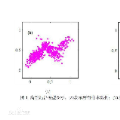Mobile robots have become more and more popular in large-scale and crowded environments, such as airports, shopping malls, etc. However, due to sparse landmarks and crowd noise, localization in this environment is a great challenge. Furthermore, it is unreliable for the robot to navigate safely in crowds while considering human comfort. Thus, how to navigate safely with localization precision in that environment is a critical problem. To solve this problem, we proposed a curiosity-based framework that can find an effective path with the consideration of human comfort and crowds, localization uncertainty, and the cost-to-go to the target. Three parts are involved in the proposed framework: the distance assessment module, the Curiosity for Positive Content (CPC), namely information-rich areas, and the Curiosity for Negative Content (CNC), namely crowded areas. CPC is introduced when the real-time localization uncertainty evaluation is not satisfied. This factor is predicted through the propagation of uncertainty along the candidate trajectory to provoke the robot to approach localization-referenced landmarks. The Human Comfort and Crowd Density Map (HCCDM) based on the Gaussian Mixture Model (GMM) is established to calculate CNC, which drives the robot to bypass the crowd and consider human comfort. The evaluation is conducted in a series of large-scale and crowded environments. The results show that our method can find a feasible path that can consider the localization uncertainty while simultaneously avoiding the crowded area.
翻译:移动机器人在大规模和拥挤环境中越来越受欢迎,例如机场、购物中心等。然而,由于稀疏的地标和人群噪声,该环境中的定位是一个巨大的挑战。此外,考虑到人体舒适度,机器人在人群中安全导航也是不可靠的。因此,在考虑定位准确性的同时,如何在这种环境中安全导航是一个关键问题。为了解决这个问题,我们提出了一个基于好奇心的框架,可以寻找一个有效的路径,考虑到人体舒适度和人群、定位不确定性以及到目标的成本。该提出的框架包括三个部分:距离评估模块,Curiosity for Positive Content (CPC),即信息丰富的区域,和Curiosity for Negative Content (CNC),即拥挤的区域。当实时定位不确定性评估不满足时引入CPC,通过沿着候选轨迹的不确定性传播来预测这个因素,从而促使机器人接近定位参考地标。基于高斯混合模型(GMM)建立了基于人体舒适度和人群密度地图(HCCDM)来计算CNC,从而驱动机器人绕过人群并考虑人体舒适度。评估是在一系列大规模和拥挤的环境中进行的。结果表明,我们的方法可以找到一个可行的路径,可以考虑到定位不确定性,并同时避免拥挤区域。




